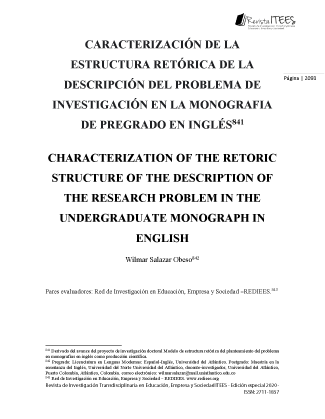CIX. CHARACTERIZATION OF THE RETORIC STRUCTURE OF THE DESCRIPTION OF THE RESEARCH PROBLEM IN THE UNDERGRADUATE MONOGRAPH IN ENGLISH
##plugins.themes.bootstrap3.article.main##
Abstract
The description of the research problem needs a rhetorical structure that accounts for its
communicative purpose. This structure linguistically hierarchizes the ideas that lead to the existence of the research problem. However, there is an absence of linguistic studies of this
section at the undergraduate level in monographs in English. The main objective of this
research is to characterize the rhetorical structure of the description of the research problem
in the undergraduate monograph in English. The study used a genre analysis, following the
CARS: Create a Research Space model by Swales (1990). 20 descriptions of research
problem from monographs written by undergraduate teachers in foreign languages from a
public university in Colombia were analyzed. The results showed: 1. An undefined
communicative purpose and rhetorical structure of the description of the research problem,
2. Lack of linguistic awareness in the realization of such rhetorical structure. It was concluded
that a rhetorical structure is required to communicate in a better way the communicative
purpose of the description of the problem.
Download Statistics
##plugins.themes.bootstrap3.article.details##
genre, genre analysis, Swales’ CARS model, research problem, monograph
Bhatia, V. (1996). Methodological issues in genre analysis. Hermes. Journal of linguistics,
16(39-59).
Bhatia, V. (1993). Analysing Genre: Language Use in Professional Settings. London:
Longman. Disponible en:
https://www.scirp.org/(S(oyulxb452alnt1aej1nfow45))/reference/ReferencesPapers.
aspx?ReferenceID=1729630
Brett, P. (2004). A genre-analysis of the results section of sociology articles. English for
Specific Purposes. 13, 1-59. Disponible en: https://eric.ed.gov/?id=EJ481597
Biber, D. Connor, U. and Upton, T. (2007). Discourse on the move. Using corpus analysis
to describe discourse structures. Philadelphia: John Benjamins Publishing Company.
Buendia, L., Colás, B., and Hernández, F. (1998). Métodos de investigación en
psicopedagogía. Madrid: McGraw-Hill.
Cárdenas, L. (2016). La lectura y la escritura en la educación superior. Alfabetización
académica en la Región Caribe colombiana. Puerto Colombia: Sello Editorial
Universidad del Atlántico.
Christie, F., & Martin, J. R. (Eds.). (1997). Genre in institutions: Social processes in the
workplace and school. New York: Continuum.
Creswell, J. (2014). Research design: qualitative, quantitative, and mixed methods. 4th
edition. Los Angeles: SAGE.
Devitt, A. J. (2004). Writing genres. Carbondale: Southern Illinois University Press.
Gomez et al. (2014). Cómo hacer tesis de maestría y doctorados: Investigación, escritura y
publicaciones. Bogotá: Eco Ediciones.
Goldkuhl, G. (2011). Pragmatism vs interpretivism in qualitative information systems
research. European Journal of Information Systems, (21), 2, 135-146. Disponible en:
http://urn.kb.se/resolve?urn=urn:nbn:se:liu:diva-76528
Hernon & Metoyer-Duran, C. (1993). What is a problem statement? Library & Information
Science Research, 29, 307-307.
Metoyer-Duran, C., & Hernon, P. (1994). Problem statements: An exploratory study of their
function, significance, and form. Library & Information Science Research, 15, 71-92.
Hopkins, A & Dudley-Evans, T. (1988). A genre-based investigation of the discussion
sections in articles and dissertations. English for Specific Purposes, 7(113-22).
Hyland, K. (2003). Second Language Writing. New York. Cambridge University Press.
Hyland, K. (2008). Genre and academic writing in the disciplines. Language Teaching,
41(04), pp 543-562.
Jalilifar, A., Firuzmand, S., & Roshani, S. (2011). Genre analysis of problem statement
sections of MA proposals and theses in Applied Linguistics. Language, Society and
Culture, (33), 85–93. Disponible en: http://scholar.google.com/scholar
Johns, A. M. (2008). Genre awareness for the novice academic student: an ongoing quest.
Language Teaching, 41(2): 237-252.
Mahjoobeh, Sh. (2015). Analysis of verb tenses and voice of research articles abstracts in
Engineering journals. International letters of social and humanistic sciences,47, P.
139-152. Disponible en: https://www.gesis.org/ssoar/home
Martin, P., and León, I. (2009). Promotional strategies inresearch articles introductions: an
interlinguistic and cross-cultural genre analysis. Revista Canaria de Estudios en
Ingles, 50. 73-83.
Millar, D. (2011). Promoting genre awareness in the EFL students. English teaching forum.
No. 2. Disponible en:
https://americanenglish.state.gov/files/ae/resource_files/promoting_genre_awarenes
s_in_the_efl_classroom.pdf
Monje, A. C. (2011). Cómo presentar la monografía de grado o el informe de investigación.
Universidad Surcolombiana.
Nimehchisalem, V., Tarvirdizadeh, Z., Paidary, S.S., & Hussin, N.I. (2016). Rhetorical
Moves in Problem Statement Section of Iranian EFL Postgraduate Students’ Theses.
Disponible en: http://www.journals.aiac.org.au/index.php/alls/article/view/2507
Parsa, s., and Hasam, M. (2017). Move Structures in “Statement-of-the-Problem” Sections
of M.A. Theses: The Case of Native and Nonnative Speakers of English. Iranian
Journal of Applied Linguistics (IJAL), 20(2), September, 195-228. Disponible en:
https://ijal.khu.ac.ir/files/site1/user_files_795657/parsa-A-10-818-2-a74c4c0.pdf
Oliveira, F. (2017). A organização retórica da seção de considerações finais do gênero
monografia em comunidades disciplinares distintas. Disponible en:
http://hdl.handle.net/123456789/544
Rozimela, Y. (2014). The students’ genre awareness and their reading comprehension of
different text types. International Journal of Asian and Social Science, 4, 460-469.
Disponible en: https://www.semanticscholar.org/paper/THE-STUDENTS%27-
GENRE-AWARENESS-AND-THEIR-READING-OFRozimela/77d921fd460addb0ed40f9061eb3aadb4419dece
Salayer-Meyer, F. (1990). Discoursal flaws in medical English abstracts: a genre analysis
per research and text type. 10, 365-384. New York: Walter de Gruyter, Berlin.
Samraj, B. (2002). Introductions in research articles: variation across disciplines. English
for Specific Purpose. 21: 1-17.
Swales, J. (1981). Aspects of article introductions. Birmingham. England: Universidad de
Aston.
Swales, J. (1990). Genre Analysis - English in Academic and Research Settings. Cambridge:
Cambridge University Press.
Zayas, F. (2012). Los géneros discursivos y la enseñanza de la composición escrita. Revista
Iberoamericana de Educación. N.º 59, pp. 63-85. Disponible en:
https://rieoei.org/historico/documentos/rie59a03.pdf





